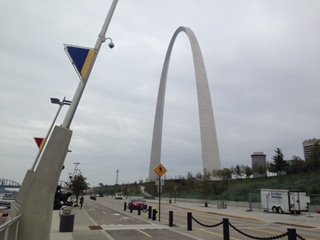Thank you for reading this post, don't forget to subscribe!

The Gateway Arch in St. Louis, Missouri is one of the most fascinating monuments in the world. It is the tallest man made monument in the United States and attracts more than four million visitors a year. If your travels take you to St. Louis this is an adventure you don’t want to miss.
The Gateway Arch commemorates the role that St. Louis played in the Westward Expansion of the United States during the 1800’s.
Jefferson National Expansion Memorial
Jefferson National Expansion Memorial is comprised of the Gateway Arch and St. Louis’ Old Courthouse. The park is a memorial to Thomas Jefferson’s role in opening the West, to the pioneers who helped shape its history, and to Dred Scott who sued for his freedom in the Old Courthouse adjacent to the Arch. The memorial also honors Thomas Jefferson’s Louisiana Purchase of which St. Louis was a part.

The Gateway Arch Construction
The architect of the 630 foot stainless steel arch was Eero Saarinen.
From 1947-1948, St. Luois officials held a design competition for the monument. Eero Saarinen’s arch design won and construction began on Feb. 12, 1963. The arch was completed on Oct. 28, 1965. The total cost of construction of the Arch came in under $15 million.
The Arch has foundations sunk 60 feet into the ground, and is built to withstand earthquakes and high winds. It’s calculated that the Arch sways up to 1 inch in a 20 mph wind, and is built to sway up to 18 inches.
When you visit the Gateway Arch you’ll have an opportunity to see a film of the actual construction from start to finish. It’s an amazing thing to watch since construction went up in sections on both sides with the goal of joining exactly at the top.
A Grand Staircase leads from the St. Louis levee up to the base of the Gateway Arch.
Getting to the Top of the Gateway Arch

Visitors are transported to the viewing room at the top of the Arch in elevator capsules. You could actually describe it as being an elevator/tram. According to the National Park Service, the trams are a one-of-a-kind invention, conceived in just two short weeks by an amazing man who never received a college degree. His name was Dick Bowser. Believe it or not, there were several ways considered to transport visitors to the top. These included regular elevators, escalators and even a Ferris Wheel.
The elevator/tram system in place takes four minutes to go from bottom to top. Each trip up and down consists of eight capsules or pods that each seat up to five people and are five feet in diameter. Each pod has a small window where you can observe the interior of the Arch as the tram travels. Because the Arch curves and is not a straight up and down, each capsule rotates approximately 155 degrees during the trip to the top of the Arch. It’s a fun four minute journey and is certainly unique.
The Viewing Room at the Top

Once at the top visitors may stay as long as they like in the observation area, which features 16 windows looking east over the Mississippi River and the Illinois communities and countryside, and 16 windows looking west over the city of St. Louis.
The views are absolutely amazing through the relatively small 7 inch x 27 inch windows.
Museum of The Gateway Arch
Underneath the Arch and under the ground floor you’ll find the Museum of The Gateway Arch. Visiting the museum lets you trace the story of the Native Americans, explorers, pioneers, and rebels who made America possible. Featuring six themed exhibit areas, this innovative and interactive museum celebrates America’s pioneering spirit.
The Old Courthouse
The original courthouse was constructed of brick in the Federal style of architecture and completed in 1828. The population of St. Louis grew three fold during this period due to the booming fur trade, and the courthouse was outgrown ten years after it opened. A second courthouse was designed by architect Henry Singleton, which incorporated the original courthouse as the east wing of the building.

The Old Courthouse in St. Louis was used to hear the Dred Scott Case of 1847. The case centered on slavery and whether a slave (Dred Scott and his slave wife) would still be slaves if his or her owner took them to a non-slave state. The case went through the courts for about eleven years. The U.S. Supreme Court ended up ruling against the Scotts.
The Old Courthouse was used for various non-judicial purposes after St. Louis built another larger courthouse due to population growth. The French family who originally donated the land for courthouse use sued to have the land given back because it wasn’t being used for the intended purpose. They lost the suit and the land was given to the Federal government.
The National Park Service began preservation of the Old Courthouse following its incorporation into Jefferson National Expansion Memorial. Additional restoration occurred in 1955.
See more articles from Trips Into History found on the links below…
Historic Union Station in St. Louis Missouri

So Much to See and Do at The Gateway Arch National Park
Enjoy a tram ride up to the top of the Arch…experience amazing views of the Mississippi River, Illinois and the City of St Louis…learn how the Gateway Arch was constructed…visit the Gateway Arch Museum…visit the the historic Old Courthouse and while you’re along the Mississippi River enjoy a steamboat ride that will show you many historic landmarks along the river bank.
(Article and photos copyright Trips Into History)

